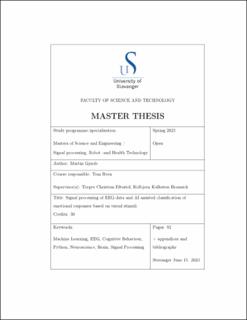| dc.contributor.advisor | Eftestøl, Trygve Christian | |
| dc.contributor.advisor | Kallesten Brønnick, Kolbjørn | |
| dc.contributor.author | Gjerde, Martin | |
| dc.date.accessioned | 2023-09-06T15:51:16Z | |
| dc.date.available | 2023-09-06T15:51:16Z | |
| dc.date.issued | 2023 | |
| dc.identifier | no.uis:inspera:129730556:36607467 | |
| dc.identifier.uri | https://hdl.handle.net/11250/3087781 | |
| dc.description.abstract | | |
| dc.description.abstract | This report outlines the research conducted to explore on the topic of classification of human neurological data using machine learning models. The primary objective was to investigate alternative approaches for efficiently interpreting EEG data and test the possibilities for predicting human emotions. During the study, data was collected by recording the brain activity of volunteering respondents using electroencephalography. These participants were exposed to visual stimuli in the purpose of provoking specific neural activity as a result of emotional responses in the brain. The collected data underwent traditional signal preprocessing techniques typically employed in EEG data analysis. Subsequently, the filtered data was subjected to wavelet transformation, both with and without synchrosqueezing. Principal components analysis was used to perform dimensionality reduction on the resulting features extracted from the data. The final model achieved a prediction accuracy of 32% when classifying between eight different classes of emotional responses based on training data from three respondents. | |
| dc.language | eng | |
| dc.publisher | uis | |
| dc.title | Signal processing of EEG data and AI assisted classification of emotional responses based on visual stimuli | |
| dc.type | Master thesis | |
